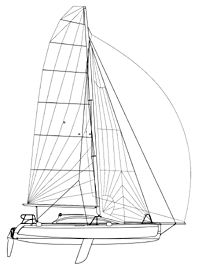Seaon 96
Multihull cruiserr
Folding trimarans are a fixture in just about every marina by now. They are a successful type and many give a very good accounting of themselves on the race course. I think the trailerability of these boats is attractive to a lot of sailors who like the option of traveling to different cruising areas and inland lakes. The Seaon is from Sweden and was designed in-house by Stefan Tornblom.
As is typical with these tris, the main hull is designed so that volume is maximized where you need it for accommodations then pared away to reduce BWL. Using the max beam of the main hull I get an L/B of 4.00. I do not have a section through the main hull or any data on BWL. I find the underwater profile and rocker distribution of this main hull very interesting. Note how the point of maximum canoe body depth is quite far aft then the rocker kicks up abruptly. As in the Raider cat this rocker shape may be a function of trying to move volume aft to preserve the desired fore and aft trim.
In a monohull you can move the keel forward and back on the drawingboard while playing with the geometry of the keel in order to balance the boat. Multihulls do not have a ballasted keel so volumetric distribution has to account totally for fore and aft trim. The rocker of the amas looks very normal. Amas will just kiss the water when the boat is sitting dead even. There are big daggerboards located in the amas. If we extend the amas the L/B is 1.31. You can retract the amas for mooring in a slip but you need to detach them from the arms to stay within the trailerable limit. The D/L for this tri is 46 based upon a displacement I think may be wee bit optimistic.
The accommodation plan is not complex. Lack of beam prevents the designer from getting too creative with the layout of the tri. The Seaon has a double berth forward with a W.C. tucked under its head. There are settee berths port and starboard separated by a minigalley. Folding counter leaves add to the available counter space on the port side of the galley. I have the same forward head arrangement on my own boat. There are disadvantages, unless, late at night, in a quiet anchorage you don't mind breaking the pristine silence and marine ecological balance with that deafening sound that might as well be a fire hose. But, given the tube-like nature of this tri, I don't see an option for the head unless you were willing to give up the only double berth on board. I would not. There are no hanging lockers and no drawers.
The most unusual feature of this layout is the elevated dining area. The cabin sole is raised about 14 inches in the way of the main settees. This gets you up where you can see out the windows and it opens up a large stowage space below the sole. It also eliminates standing headroom in this area. Photos show the interior of the Seaon to be beautifully finished, sparse but very attractive and tasteful.
The cockpit of the Seaon is pretty large and extends all the way to the stern. The cockpit is bisected by the bridge for the mainsheet traveler, and while this is less convenient for movement it is perfectly convenient for controlling the mainsail. This tri has lots of sail area and if I use their figures for sail area I get a SA/D of 49.6. Of course this includes roach area of the main.
I have a neighbor on the next beach who keeps his folding tri on a mooring. He must like this boat. He daysails it by himself all the time. He always seems to be moving quite well and he covers a lot of ground. There is no question that these folding tris can be quite fast. Some day I'm going to paddle down in my kayak and ask him for a ride.

Comments